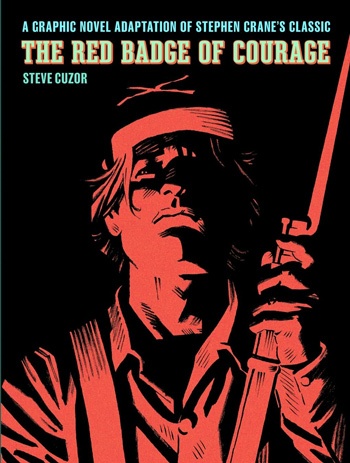Written and Illustrated by Steven Cuzor
Based on the novel by Stephen Crane
Published by Abrams ComicArts
Do we really need another adaptation of this classic novel?
I remember seeing one when I was a kid by Classics Illustrated and a quick Google search shows me that there have been other adaptations as well.
Having already read the book in high school, I wasn’t sure that I would enjoy this at all. I already knew the story and there didn’t seem to be much you could add to it.
With all of that in mind, I dove into this book. The first thing that I noticed a few pages in while reading is that this book is dense. That’s not a bad thing, but it did require me to sit down and really focus on all of the details. It is really worth it if you do that.
There is a lot in this book and I wanted to make sure that I was able to experience it all.
This graphic novel is the classic story of Henry Fleming, who is a teenager who enlists with the Union Army in the hopes of fulfilling his dreams of pride and glory. Henry is a lot like any young male would be. He is full of hope and eager to make a name for himself and make his mark on this world. He has something to prove and cannot wait to get started. Crane writes about this fairly vividly.
Cuzor does an extraordinary job illustrating this in his adaptation. The added details that come in through the line drawing really gives the work a new and exciting perspective.
The reader gets to see Henry enlist and go through what every person who becomes a soldier has to go through emotionally. Shortly after enlisting, the reality of Henry’s decision to enlist really starts to set in. He experiences long bouts of waiting around. He doesn’t become the hero he wants to become right away. The more he waits around for a battle to happen, the more doubt and fear creep into his young and impressionable mind. It is a slow burn at first, but it all leads to something.
Finally, it becomes time. Henry gets to experience his first taste of combat. It nothing like he thought it would be, of course. It is chaos and madness, and it all goes downhill quickly. When he finally has a chance to show what he is made of, he blindly fires into the battle haze, never seeing his enemy, like a complete fool. As the next round of enemy soldiers attack,, Henry’s fears of death completely overwhelm him, and he runs from the field, like a complete coward. Henry hides away scared for some time, even after he overhears that his regiment has pushed back the enemy.
When he finally slows down and rests, he hears the sound of a new and crazy battle and, ironically, he returns to the place from which he ran from initially. He also comes upon many wounded men from his regiment returning from the front to get medical assistance.
One of these wounded soldiers, identified as “a tattered soldier,” befriends Henry and begins a conversation with him. At this point, we get to the moment that hit me hardest when I read the book in high school. That is because when the tattered soldier asks Henry where he is wounded, Henry evades the question by leaving him and drifting into the crowd of soldiers.
It just gets worse from there.
As Henry continues walking along with the wounded, he sees a veteran soldier of his company, Jim Conklin, who is mortally wounded. Henry follows Jim, and, eventually, the tattered soldier joins them. When Jim suddenly collapses and dies, Henry is devastated. The tattered soldier again asks Henry about his wound. Again, Henry can’t explain that he has no wound, so he leaves the disoriented, wounded, tattered soldier stumbling in the field, again like a coward. From there, Henry has a journey to becoming the man he wanted to be originally. He finds to bravery and courage he longed for at the beginning, but in a completely different way than he thought.
Seeing it illustrated like this is completely glorious, and I have to commend writer/artist Steven Cuzor. I asked at the top: “Do we really need another adaptation of this classic novel?”
The answer is yes, but only if they are as powerfully done as this one. The writing and artwork are perfect.
RATING: A












